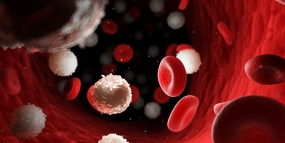How blood stem cells maintain their lifelong potential for self-renewal
A characteristic feature of all stem cells is their ability to self-renew. But how is this potential maintained throughout life? Scientists at the German Cancer Research Center (DKFZ) and the Heidelberg Institute for Stem Cell Technology and Experimental Medicine* (HI-STEM) have now discovered in mice that cells in the so-called "stem cell niche" are responsible for this: Blood vessel cells of the niche produce a factor that stimulates blood stem cells and thus maintains their self-renewal capacity. With the decades of life, the production of this factor ceases and blood stem cells begin to age.

Their self-renewal potential is the prerequisite for blood stem cells to provide sufficient replenishment of mature blood cells for decades.
© Adobe Stock
Throughout life, blood stem cells in the bone marrow ensure that our body is adequately supplied with mature blood cells. If there is no current need for cell replenishment, the blood stem cells remain in a deep sleep to protect themselves from damage to the genome, which can lead to cancer. Blood loss, infections and inflammations act like an alarm clock: immediately, the blood stem cells begin to divide and produce new cells - for example, to provide immune cells to fight viruses or to compensate for a loss of red blood cells or platelets. With each cell division, the stem cells always regenerate themselves as well, so that the stem cell pool is maintained. This is what scientists call self-renewal.
"The dormancy is the prerequisite for this unique ability of stem cells," explains Andreas Trumpp, a stem cell expert at DKFZ and HI-STEM. The almost unlimited self-renewal capacity is considered a key property of the very rare stem cells, which play a central role in the maintenance and repair of tissues and organs. However, cancer cells also possess this ability. They either derive directly from stem cells or acquire this ability through genetic modification. "Without self-renewal, there is no cancer," Trumpp sums it up.
A team of researchers led by Andreas Trumpp now wanted to find out which molecular signals control the self-renewal ability. In their current analyses, they discovered in mice that dormant blood stem cells carry large amounts of the receptor protein neogenin-1 (Neo-1) on their surface. In contrast, other blood cells do not produce this receptor. Further investigations revealed Neo-1 to be a key molecule for self-renewal: if the researchers genetically switched off the receptor in mice, the stem cells no longer slept, thus losing their ability to self-renew, and the animals' hematopoietic system exhausted prematurely.
Neo-1 is a receptor that enables the stem cell to receive external signals. But where do these important signals, which are essential for the self-renewal ability, come from? The researchers identified the signal molecule netrin-1 as the binding partner and activator of the Neo-1 receptor. Netrin-1 is produced by the endothelial cells that line the fine blood vessels in bone marrow. "We genetically knocked out netrin-1 in the stem cell niche of mouse bone marrow. The blood stem cells then lost the ability to self-renew. In contrast, when netrin-1 production was experimentally increased, they slept all the more deeply," said Simon Renders, first author of the study.
Scientists refer to the structures in the immediate vicinity of stem cells as a stem cell niche. The niche can consist of cellular and non-cellular components and exerts a major influence on the functions and fate of blood stem cells. Netrin-1-bearing cells of blood capillaries are also part of the niche. "Our results reconfirm the central role of the stem cell niche for stem cell function and thus for the regenerative capacity and health of our body," Trumpp explains.
The age-related depletion of the hematopoietic system could also be traced in the animals: With age, the bone marrow changes its structure, and the tiny blood vessels degenerate. Using older mice, the scientists were able to show that this is accompanied by a loss of netrin-1. The blood stem cells initially try to compensate for this lack of their important signal generator by increasing the formation of neo-1. However, with increasing age, this compensation is no longer sufficient, and the hematopoietic system increasingly loses its self-renewal capacity. The result of these changes is an increasingly weaker immune system in old age.
*The Heidelberg Institute for Stem Cell Research and Experimental Medicine (HI-STEM) gGmbH was founded in 2008 as a public-private partnership between the DKFZ and the Dietmar Hopp Foundation.
Simon Renders, Arthur Flohr Svendsen, Jasper Panten, Nicolas Rama, Maria Maryanovich , Pia Sommerkamp, Luisa Ladel, Anna Rita Redavid, Benjamin Gibert, Seka Lazare, Benjamin Ducarouge, Katharina Schönberger, Andreas Narr, Manon Tourbez, Bertien Dethmers-Ausema, Erik Zwart, Agnes Hotz-Wagenblatt, Dachuan Zhang, Claudia Korn, Petra Zeisberger, Adriana Przybylla, Markus Sohn, Simon Mendez-Ferrer, Mathias Heikenwälder, Maik Brune, Daniel Klimmeck, Leonid Bystrykh, Paul S. Frenette, Patrick Mehlen, Gerald de Haan , Nina Cabezas-Wallscheid & Andreas Trumpp: Niche derived netrin-1 regulates hematopoietic stem cell dormancy via its receptor neogenin-1
Nature Communications 2021; DOI: https://doi.org/10.1038/s41467-020-20801-0
With more than 3,000 employees, the German Cancer Research Center (Deutsches Krebsforschungszentrum, DKFZ) is Germany’s largest biomedical research institute. DKFZ scientists identify cancer risk factors, investigate how cancer progresses and develop new cancer prevention strategies. They are also developing new methods to diagnose tumors more precisely and treat cancer patients more successfully. The DKFZ's Cancer Information Service (KID) provides patients, interested citizens and experts with individual answers to questions relating to cancer.
To transfer promising approaches from cancer research to the clinic and thus improve the prognosis of cancer patients, the DKFZ cooperates with excellent research institutions and university hospitals throughout Germany:
The DKFZ is 90 percent financed by the Federal Ministry of Education and Research and 10 percent by the state of Baden-Württemberg. The DKFZ is a member of the Helmholtz Association of German Research Centers.

